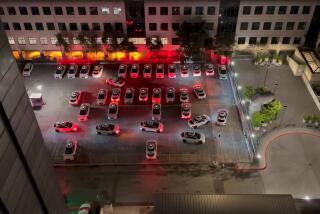The Hands-On Approach to Gridlock
- Share via
Faced with daily gridlock for the first time at a San Fernando Valley intersection, transportation experts have resorted to an old-fashioned method of controlling traffic: human hands.
Two white-gloved Los Angeles traffic control officers have been assigned to direct cars through the jammed intersection of Ventura and Sepulveda boulevards in Sherman Oaks during the morning rush hour.
The officers are supplementing conventional automated signal lights to keep backed-up traffic from completely clogging the intersection, officials said.
An estimated 86,238 cars pass through the intersection--bordered by high-rises--daily to make it the Valley’s busiest, according to transportation engineers.
The arm-waving has been so successful at hurrying cars through the intersection that transportation experts are considering using officers at other busy corners in the Valley, officials said Monday.
A city Department of Transportation helicopter is being used to hunt for recurring traffic jams at other Valley intersections, said traffic control supervisor James Daniel, one of those involved in the aerial inspection.
Growing Problems
Problems at the Sherman Oaks intersection have been growing for years. Besides serving six nearby high-rise office buildings, it serves the Sherman Oaks Galleria shopping center, which has 3,500 parking spaces, and an increasing number of nearby apartments and condominiums.
The intersection also funnels morning traffic onto both the San Diego and Ventura freeways. Traffic officers have been used for years to augment traffic lights in downtown Los Angeles. Fifteen busy central-city intersections are normally manned during rush hours, according to officials.
Until now, however, police officers or gray-uniformed parking enforcement officers, such as those assigned to the Sherman Oaks intersection, have only been used when lights were knocked out by power failures.
“But we’re getting like downtown with our traffic,” said Bernadine Westmoreland, a Valley traffic enforcement supervisor. “When the signals change at a busy intersection, you do not want people blocking traffic in the opposite direction.”
Although the officers usually follow the lights, they can halt advancing cars or left-turning vehicles when traffic farther ahead is blocked, Westmoreland said.
“They usually don’t override the lights unless there’s so much congestion that they want to empty out the intersection,” she said. In those cases, motorists are supposed to obey the traffic officer--not the traffic light.
Officials said drivers’ reactions to the Sherman Oaks officers have been mixed. “Especially at first, people might have thought, ‘Gee, I could have made that light if it wasn’t for the officer,’ ” Westmoreland said.
Motorists were still giving the new system mixed reviews Monday.
“It seems to be working, from what I’ve seen,” said Scott Foley, who has a clear view of the street from his security-guard post at a 22-story high-rise. “They don’t let people take a left and tie up the lanes after the light changes.”
But Jim Richcel, who passes through the intersection at 8:15 a.m. daily on his way to his nearby publishing company office, said he hasn’t noticed much of a change. “Sepulveda is still backed up at least a mile. Whether they’re there or not doesn’t seem to make much difference,” he said.
Added Melissa Menzies, a teller at a bank a few steps from the intersection: “I think this corner is a hopeless case.”
More to Read
Sign up for Essential California
The most important California stories and recommendations in your inbox every morning.
You may occasionally receive promotional content from the Los Angeles Times.














